|
PAPER MODELS |
| latest update: 10th of January 2009 |
| home |
|
Perhaps they used Papyrus in ancient Egypt also for building models.
Perhaps they used paper for modelling purposes soon after paper was
invented in China two thousand years ago. We don´t know very much about
it. Paper
is a wonderful material for model building. It does not require a lot of
sophisticated tools but it is a living material giving you immediate
response to your artistic ideas. Paper could be very different. Hard,
soft, thin, thick, porous, glossy, ugly, beautiful. Paper could take and
give back colouring in the most different ways. There are so many
qualities inspiring you. During the 19th century, several printing companies developed nicely coloured and printed paper model kits aiming at children. After the first world war, the interest grew to design scale model kits for boys interested in miltary technology, ships and airplanes. In the late 19th century, paper modelling turned out to be a very sophisticated hobby for people with the highest demands for beauty and accuracy. Modern glues and paper qualities allowed it. The pictures on this page just give some examples from the history
of paper models. I have also written special pages about Gunnar Sillén
|
|
| The oldest handbook concerning the art of making paper
models was as far as I know printed in Germany in 1802. The author was
Heinrich Rockstroh and one of his wishes was to help craftsmen to find new
outcomes through the playtoy "industry". The book gives
instructions for the geometrical design of different surfaces and also has
a lot of nicely etched plates with examples. I have copied some of the
etchings to card and built the models as shown on this picture. The complete name of the book is: Rockstroh, Heinrich: Anweisung zu Modellieren aus Papier, Weimar 1802. a reprint with comments by Dieter Nivergelt was published in 2008 |
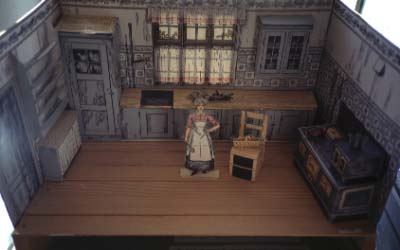 |
Most successful in making paper models popular in
Scandinavia was the weekly magazine Familj-Journalen (Allers) that started
in Denmark but was so popular that it also published Swedish and Norwegian
editions. From 1914, the Danish drawer H.C.Madsen provided the magazine with as well
cut-out models as jigsaw-models. Till his death in 1939, he designed
one, two or even more models for the magazine every week. Fancy models,
doll houses, famous architecture. The models he designed are still very
pleasant to build. The constructions are engenious. The fit is excellent.
The artwork is living. This kitchen is from 1917. |
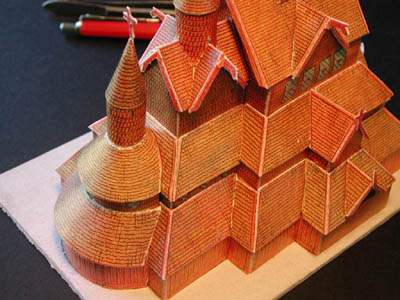 H.C.Madsen draw this Norwegian stave church in 1928. |
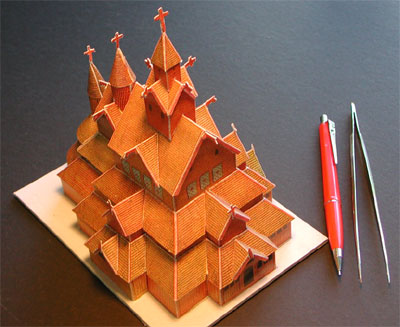 |
| In the 1930-ies, Allers and the Familje-Journalen laid more stress on giving their readers a nicely presented geographical and technological education. The cut-outs often reproduced famous pieces of architecture or folk art. They had a special series of cut-outs called "Street of the Nations", probably inspired by the collection of houses from all over the world at the Paris World Exhibition in 1900. This model of the Mostar bridge might be the last model that H.C.Madsen designed. It was published in 1940. | 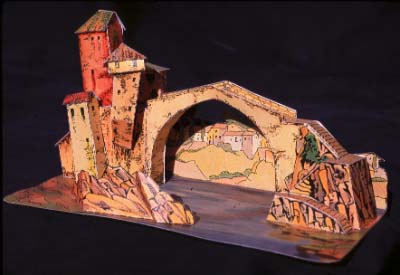 |
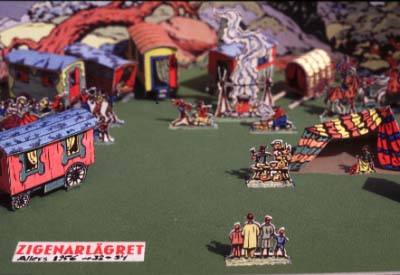 |
During the 1940-ies, the Swedish edition of the Allers
magazine got a more independent position in relation to its Danish owners.
The popular publishing of cut-outs went on, but now with Swedish
designers, most of them unfortunately anonymous. New after the war was an
interest in scale modelling. Houses were often drawn in scale 1:87 to meet
the growing HO model railroad hobby. The picture shows an 1:87 gipsy camp
that was published as late as 1956. Few years later the magazine stopped
publishing paper models. Young people by then demanded plastic models
instead. But for all older people in Sweden, the name of the Allers magazine is forever associated with paper cut-out models. |
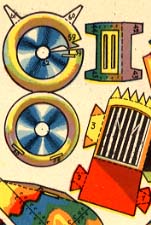 |
This is an old Italian model of an armoured car or "Auto Blinda" as it says on the cut-out sheet. The model is designed with self locking tabs that make building without glue possible. Especially the 3-D wheels are cleverly constructed (hardly visible on the completed model but here shown in detail to the left) even if the fit is not the most perfect I have seen. Publisher was the Editrice "CARROCCIO" in Milano. I don´t know when the model was printed and if it has any resemblance with an armoured car that has really existed. Please tell me if you know. | 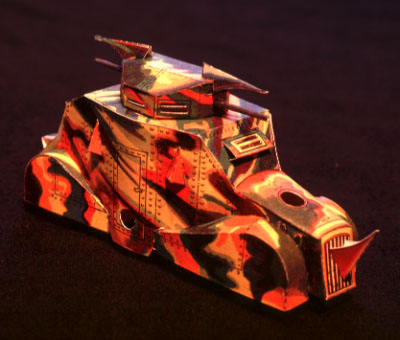
|
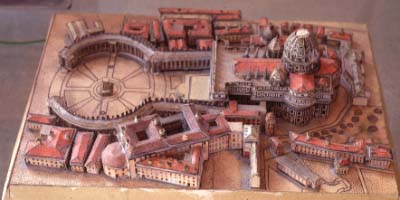 |
Legendary are the unbelievable small Micromodels, designed and published by Geoffrey Heighway in England from 1947 to 1956. Over 100 different models were printed on 9x13cm cards and enveloped. Architecture, ships, railroad stock and whatever you like. This picture shows the tiny little model of St. Peters and Vatican in Rome. It was printed on 12 cards. |
|
|||||||||||||||||||||||||||||||||||||||||
|
|